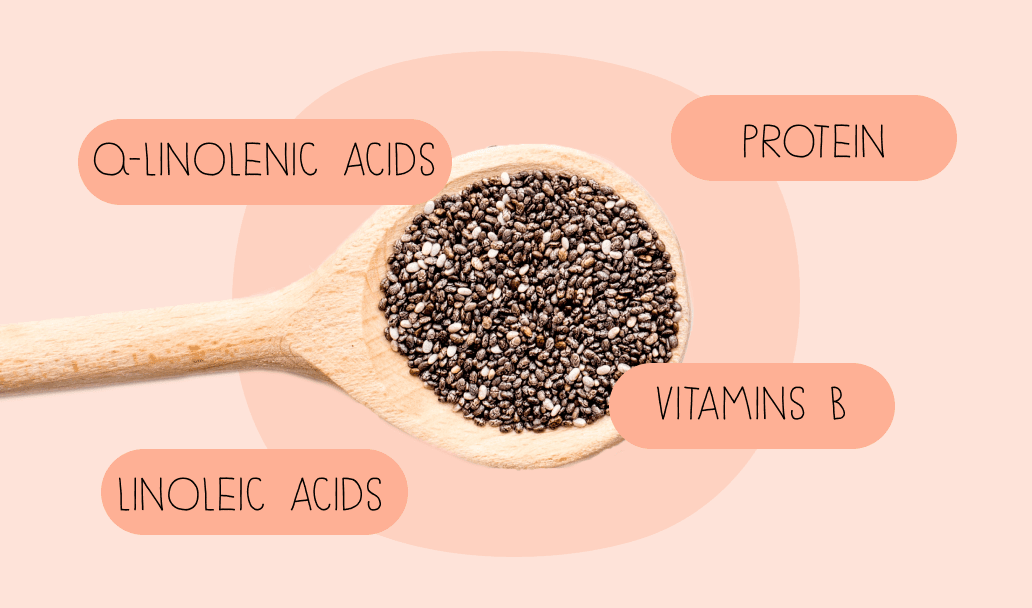Influencers and bloggers recommend Chia to people who want to lose weight effectively. But do these teeny-tiny seeds actually work as a magic bullet, and why have originally called Mexican mint seeds become a popular superfood all over the world. Let's find out together!
Salvia hispanica is a flowering plant native to central and southern Mexico, and it's known for black seeds called Chia. Years of scientists' investigations proved Chia's unique nutritional composition and potential health effects. 100 g of chia seeds are the source of:
Eat tasty food and lose weight with Unimeal app!
Take a Quiz – Get personal meal plan – Achieve your weight goals!
Start QuizChia contains vitamins (mostly B complex), minerals (calcium, phosphorus, potassium), and other bioactive compounds, such as antioxidants and Omega-3. The 2019 study showed that the nutritional composition of chia "relates to different medicinal effects, particularly anti-inflammatory and antidiabetic activities, and positive ones on cardiovascular disease and hypertension"1Diana Melo, Thelma B Machado, M Beatriz P P Oliveira. (2019, June 19). Chia seeds: an ancient grain trending in modern human diets. Food Funct. DOI:10.1039/c9fo00239a.

The notion that chia helps to lose weight comes from high fiber content – 2 tablespoons of these seeds contain almost 10 grams of fiber. Fiber is known to help regulate digestion, move toxins and reduce fat levels in the body. Many diets are based on a high fiber menu, which keeps you full for a more extended period. A scientific work published in the European Journal of Clinical Nutrition found that chia seed intake reduced appetite and increased feelings of satiety in participants to a certain extent2V Vuksan, et al. (2017, February). Salba-chia (Salvia hispanica L.) in the treatment of overweight and obese patients with type 2 diabetes: A double-blind randomized controlled trial. Nutr Metab Cardiovasc Dis. DOI:10.1016/j.numecd.2016.11.124. There is not enough medical research made on the theory that eating or drinking chia seeds helps you lose weight. But of course, chia seeds can be a part of a weight-loss program3V Vuksan. (2016, December 21). Comparison of flax (Linum usitatissimum) and Salba-chia (Salvia hispanica L.) seeds on postprandial glycemia and satiety in healthy individuals: a randomized, controlled, crossover study. EJCN Retrieved from https://www.nature.com/articles/ejcn2016148.
Drinking Chia Water became a popular TikTok trend. The recipe is as easy as it sounds: a spoonful of chia seeds dropped into a glass of water. Chia seeds absorb water 12 times their weight, and the ready-made drink has an unflavored gelatinous texture (close to tapioca). Drinking this healthy cocktail takes up space in your stomach and prevents you from getting hungry for a couple of hours. As you become less hungry, you eat less and lose weight.

Chia seeds taste rather bland, so you can add them to almost anything in a raw or soaked condition. Just like overnight oats, chia seeds need to be soaked in milk or water for more than 5 hours. It helps to germinate fully and eliminate digestive inhibitors (which act as a protective layer). While there's no actual harm in eating chia seeds, soaking them in liquid for hours could also allow you to extract all its nutritional benefits. Plus, the water it soaks up keeps you hydrated. Here are a few ways how to properly use chia seeds:

As we mentioned before, chia seeds are super high in dietary fiber. This nutrient may aid digestion, lower cholesterol levels, help control blood sugar levels, and make it easier to maintain a healthy weight. But overeating fiber, though, may cause more harm than good. These tiny seeds contain between 34 and 40 percent fiber per 100 grams. That's little more than the daily recommendations for healthy adults. Dietary fiber is a carbohydrate found in plant foods bound together so that it cannot be easily digested in the small intestine. So while it enables intestinal regularity and may decrease the risk of developing heart disease, some risks may appear from eating too many chia seeds. According to the studies, your total dietary fiber intake should be between 25 and 30 grams daily. There are some possible chia seed side effects for people with irritable bowel syndrome and diverticulitis. So, if you have these conditions, you should consult your doctor before adding these seeds to your menu. Also, when you increase your fiber intake too fast, you may feel gas, bloating, and cramps4Nutrition Services. (2020). Fiber-How. Duke Student Health Nutrition Services. Retrieved from https://studentaffairs.duke.edu/sites/default/files/u110/TooMuchFiber082015.pdf.
Chia seeds are straightforward to integrate into recipes. You can try the recipes from our cooking hub!
Chia seeds are taking the world by storm. Despite its small size, this superfood contains a lot of fiber, protein, and heart-healthy fats. It's an ideal addition to all kinds of diets. But the most pleasant plus is being a great help to maintain healthy weight. However, a recommended daily dosage shouldn't be ignored as there are some risks of experiencing side effects.
Unimeal does not diagnose or suggest treatments. Any description of the diet, training plan or supplement should be discussed with your current physician or nutritionist. This article does not address specific conditions and is simply meant to provide general information on healthcare topics. Following any advice is at your own initiative and does not impose any responsibility on the blog authors for your health and safety.
Sources:
By choosing high-quality sources, we make sure that all articles on the Unimeal blog are reliable and trustworthy. Learn more about our editorial processes.
1.
2.
3.
4.
Related Articles